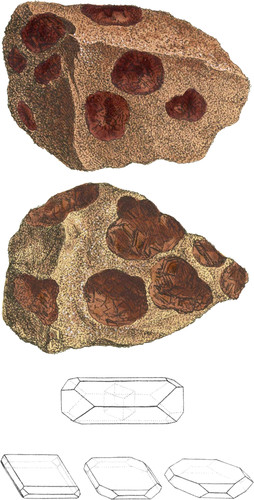 Enlarge
Enlarge
British Mineralogy
Sulphate of Strontian
It is not every where that opportunities offer of examining rocks, but geology will be much facilitated by the knowledge of such as are most minutely explored, while others are only partially so. Thus, the Carbonate of Strontian was first discovered at Strontian in Scotland, by examining the rock tor metals; and afterwards Sulphate of Strontian was discovered near Bristol in rocks exposed tor other purposes, and now continuing to be useful. The continued researches cause a variety of discoveries;—and while the general substance of the rock is known*, the contents of other rocks not yet examined may, in a great measure, be presumed. Thus my highly esteemed and ingenious friend Dr. Murray of Harrowgate, in company with Sir Thomas Slingsby, bart., discovered Sulphate of Strontian similar to that of Bristol, on the banks of the river Nidd, near Knaresborough, in an apparently similar rock; and our diligent President of the Geological Society met with Sulphate of Barytes about fourteen miles to the eastward, in apparently the same kind of rock as the Sulphate of Strontian from Aust passage near Bristol. It is thus that the same deposit or formation of rock may be known by a similarity of substances. Sulphate of Barytes is sometimes found in the Bristol rocks, as my active friend W. Dauby, esq. and others, have sent me specimens accompanied with Galæna and Blend: it may be presumed that the same may be found at Knaresborough; and therefore while I am showing the productions of one place, those of another will be inferred; and if coincidence continue to help our inferences, it will become so absolute a certainty that no one will be at a loss to know the nature of a spot, even underground, and tell whether it is worth the expense of further examination for treasures out of sight.
The present specimen is an example of a sort of small nests of crystals of Sulphate of Strontian, spotting the rock in a remarkable manner, and also a red variety of Cœlestine, comparative, however, of the cœlestial regions when beginning or ending the day delightful! These nests or druses, as some may call them, were found in excavating the canal, and are occasionally very fine, with somewhat larger crystals in them. The present are chiefly as represented in the lower geometrical outline.
Just as I was executing these, my good friend W. Danby, esq. sent me a specimen from near Knaresborough with elongated crystals, much resembling the Nutfield Sulphate of Barytes, but of a pale blue colour and smaller. I add a figure of the form with the nucleus.
Specimens of nearly while Sulphate of Strontian are found at Barry Island, South Wales, that have tables like the lower figure. My specimen was given me by Mr. Herbert of Bristol. It will be seen how the faces differ from the columnar to the tablet or table form by a slight attention to the outlines.
- * This rock, generally speaking, is understood to be the Red Sand formation holding Gypsum sometimes nearly similar in appearance: see tab. 236.

